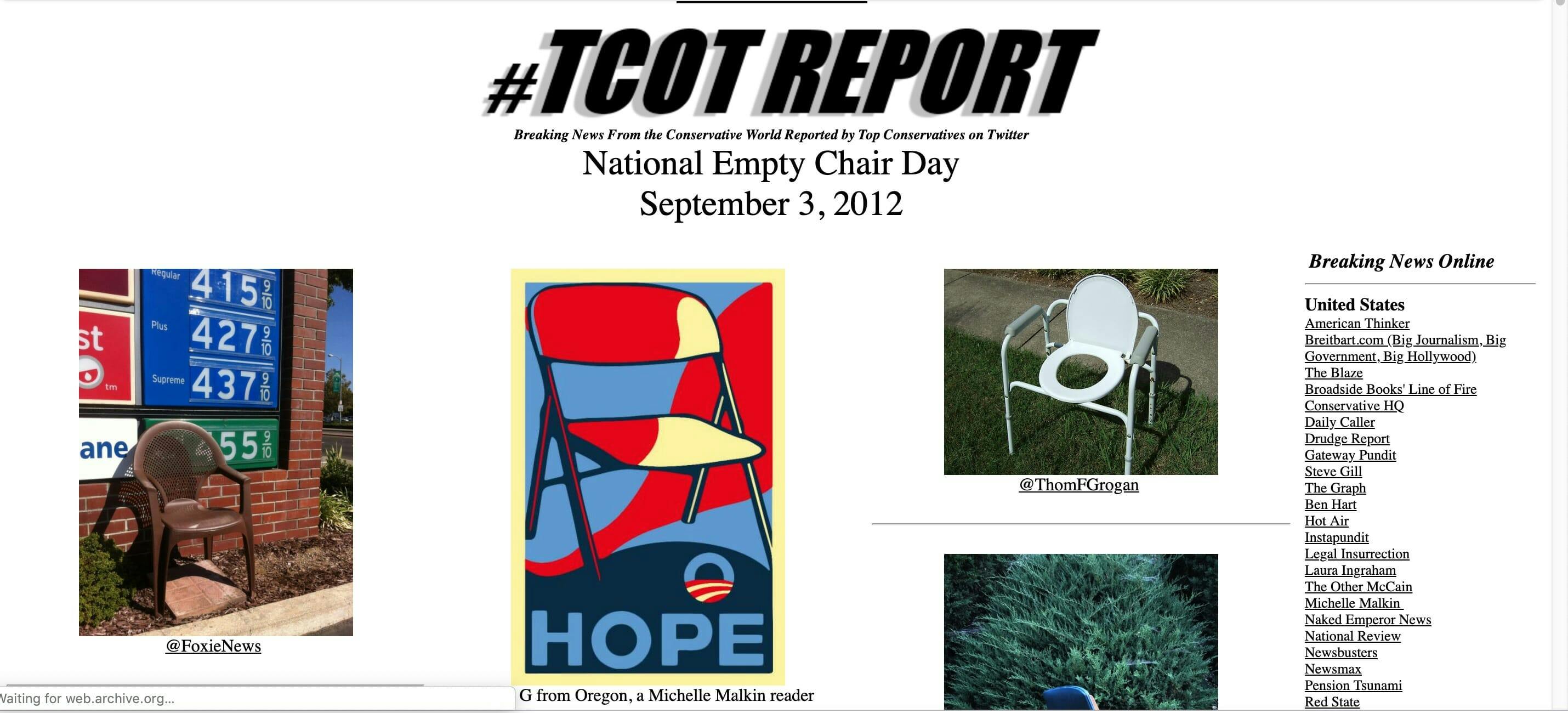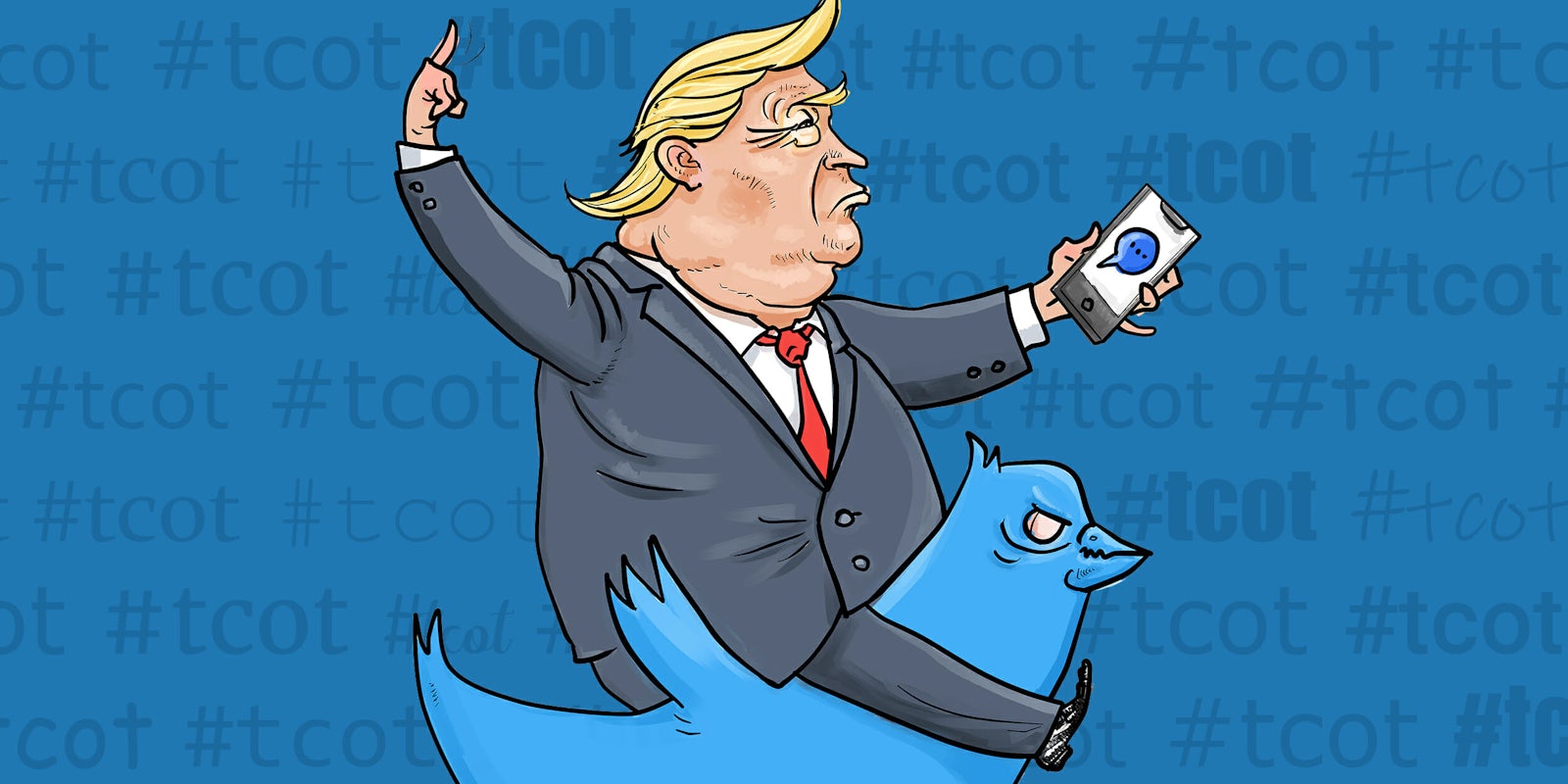Great hashtags don’t die, they just fade away.
If you search #TCOT on Twitter these days, sure, you’ll get results. You might even see a tweet from a few minutes ago. But, it will likely have only have a few favs, and a retweet or two. A visit to the top tweets from the hashtag show a particularly dire state of affairs. Few tweets have more than a dozen favs. Some have no engagement at all
https://twitter.com/libertybell1776/status/1136666884948910080
You would never know that #TCOT was once the most important political hashtag on Twitter.
#TCOT, which stands for “Top Conservatives On Twitter,” was the conservative hashtag that dominated the first half of the 2010s. In a pre-MAGA era, tea partiers, fiscal conservatives, white supremacists, and other flag-waving, red-blooded patriots used the hashtag as a signal that they were owning the libs.
And then, all of a sudden, the hashtag died.
The cause of death is fairly obvious. We now know who the top conservative on Twitter truly is: he is sitting in the White House. Furthermore, whether through dumb luck or genius social media foresight on the part of the Trump campaign, another four-letter hashtag, #MAGA, has seamlessly replaced #TCOT.
But tracking the rise and fall #TCOT offers a clear timeline of how the right went from a bunch of angry self-styled lone wolves, rebels, and “patriots” to taking back the White House.
It’s important to note that #TCOT stands for “top conservatives on Twitter,” not “top conservative.” The hashtag was imagined as a call to other right-wing posters, a signal for members of a group on the margins. Early posters on #TCOT imagined it as a kind of sign to fellow travelers who have found themselves in exile in the age of Obama.
The #TCOT hashtag was first popularized in November of 2008. It is no coincidence this came with Barack Obama winning a clear presidential mandate. It is also no coincidence that the popularity of the hashtag grew as the Tea Party movement gained traction throughout 2009.
Obama’s 365-173 victory in the Electoral College signaled that the Bush era was that brand of aww shucks jingoism wasn’t going to work anymore. But, no one was sure what would.
They found a brand, in being feisty online.
When Michael Patrick Leahy, a major figure in the early days of #TCOT and self-proclaimed founder of the hashtag, describes conservatives at that time, he describes a group on the sidelines. After he launched a website tracking the hashtag called TCOTReport.com (no longer active) in 2009, he told ABC that he started the site because there was a perception that liberals dominated online, and conservatives wanted a way to talk to like-minded loners.

He said, “It turns out there were a lot of conservatives on Twitter. They were A, lonesome, and B, competitive. They wanted to get on top of the list.”
In an interview with conservative website Newsbusters, Leahy expanded on this idea:
“[I thought] Oh gosh, the left dominates the internet, we have no hope…I put this list up, and I thought, ‘Well I’ll update it tomorrow.’ No—turns out conservatives were all over Twitter, but they were lonesome. They wanted to talk to each other. So conservatives—and I ordered the list by the number of followers they had, right. So there was this prestige to being the number one top conservative on Twitter.”
The names that would appear on the list ran the gamut from prominent right-wingers to totally obscure commentators. While names like Michelle Malkin, Dana Loesch, and Erick Erickson make appearances, some of the “top conservatives” are unknowns like Brooks Bayne and Rick Abbott.
#TCOT became a place where lonely, disgruntled, mostly older, mostly white, mostly male posters could vent their anger at Benghazi, Nancy Pelosi, Muslims, and any other cause du jour the conservative blogosphere pushed them towards. The hashtag churned up disparate, often seemingly completely unrelated, grievances, taking up new causes with each news cycle.
But what powered it was always the same: an undercurrent of anger and alienation that cursed through the timeline.
By 2012, the hashtag had existed for years, and along with “#TeaParty,” shared the distinction of being one of the most dominant political hashtags on Twitter. And online movement then had an electoral test.
After Mitt Romney’s defeat at the hands of Barack Obama, the consensus was that #TCOT had created little more than digital sound and fury. An Atlantic article that December pointed out, “Unfortunately for conservatives, [#TCOT] Twitter influencers haven’t figured out how to turn a loud, hashtag-based trending topic into real, vote-based results.”
The New York Times echoed this conclusion with an article titled, “A Big Year for Conservatives on Twitter, If Not at the Ballot Box.”
But, really, Mitt Romney was not a #TCOT candidate. The problem was that it wasn’t issues that united the #TCOT crowd, it was feelings. Romney ran on their policies, but did not share their anger.
When leaders in the movement like Leahy would talk about #TCOT, they talked about how conservatives felt alienated, lonesome, competitive, or angry, not about tax cuts or a muscular foreign policy. In 2016, when Trump ran a campaign light on policy and heavy on emotion, he was criticized by the media, but it turned out that he was simply learning the lessons of the hashtag he had spent the better part of a decade living inside of.
In a sense, Trump was a product of #TCOT, but he also killed #TCOT. When he started sharing the same grievances as the TCOT crowd at his rallies and press conferences, the top conservatives could no longer feel like they were a part of a small club. As red MAGA hats became a common sight from Michigan to Arizona, these prolific posters could no longer feel like they were a part of a small exclusive and alienated club.
#TCOT built the early infrastructure that would birth MAGA.
And ironically, once Trump arrived on the scene, #TCOT was quickly no longer relevant. To other aspiring conservatives, bringing this group together was like herding cats, but Trump’s campaign saw through the particular issues had common threads: alienation, anger, and bigotry.
In short order, there would no longer be a contest to become the top dog, because it was clear who the TCOT really was. If you look at a list of top #TCOT accounts from 2013, you see a group of people that have either totally bent the knee to Trump or rendered themselves irrelevant: Newt Gingrich, Sarah Palin, Sean Hannity, and Glenn Beck.
It’s almost poetic that President Trump last used #TCOT in one of his tweets on May 13, 2015. He descended the Trump Tower escalator a month later, beginning his presidential campaign on June 16th.
Looking forward to touring the @sigsauerinc world headquarters tomorrow! One of the top gun manufacturers in the US! #GunRights #TCOT
— Donald J. Trump (@realDonaldTrump) May 13, 2015
#TCOT, with its built-in image of lonesome, persecuted victimhood could only exist as it was while right-wingers were (or at least perceived themselves to be) in the political wilderness. Trump’s team realized figured out how to take that feeling of alienation, of being out of step with the times, and brought it to the ballot box.
Wearing a Make America Great Again hat expresses the exact same feelings that #TCOT once vented. Suddenly, conservatives were all alienated together.
#TCOT is dead, but #TCOT lives on both in the rhetoric and policy of the Trump administration. President Trump’s policies are steeped in victimhood. Americans are victims of illegal immigration. White men are victims of affirmative action. Baby Boomers are victims of ungrateful millennial grandchildren. Conservatives are victims of an unfair and biased media. That unearned sense of victimhood is the true legacy of of #TCOT.
Though #TCOT is dead, the president is its embodiment. #TCOT is about allowing the wealthiest gender of the wealthiest race of the wealthiest age group of the wealthiest nation in the world to perform victimhood.
And now, conservatives don’t even have to post about it: the president is doing it for them.
READ MORE:
- Ashley St. Clair says an Uber driver attacked her pro-Trump views. It’s #MAGAphobia nonsense
- VoxAdpocalypse, the conservative rallying cry against YouTube, explained
- Conservatives call for Netflix boycott after company threatens to pull out of Georgia
- Minions memes are more popular than the far-right on Telegram
Got five minutes? We’d love to hear from you. Help shape our journalism and be entered to win an Amazon gift card by filling out our 2019 reader survey.


